The old saying “you get what you pay for” applies to gun safes, but not necessarily for security. With most gun safes, what you are paying for is nice paint, chrome, decorative items, and interior.
Typical gun safes sell the appearance of protection in a security container that can be broken into in a couple minutes with pry bars or an ax.
Below, recommendations for top rated gun safes are broken into 3 different protection and budget categories:
Prices range from inexpensive gun safes to high-security true safes. All models included here maximize the actual protection per dollar.
Keep in mind that you don’t have to buy new. You can often find a used true safe for less than a new cheap gun safe.
Let’s take a look at the new gun safe models available.
Best Cheap Gun Safe (RSC Attack Level 1)
If you’ve decided you want a traditional-style cheap gun safe, you’ll be looking at models with and without Underwriters Laboratories 1037 Residential Security Container (RSC Attack Level 1) ratings. (RSC ratings before 9/2016 are equivalent to RSC-I.)
A RSC-I rating means that the gun safe was independently tested at UL to take 5 minutes for one person to break into it with basic hand tools. Larger hand tools, two guys, or power tools will get inside most RSC-I’s in less than a couple minutes.
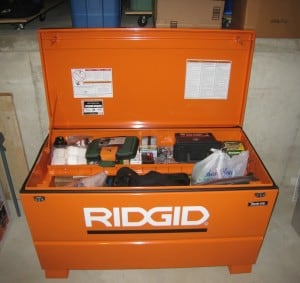
Sometimes the best cheap gun safe is a job box. A happy reader took my advice and bought this one at Home Depot ($250 at the time).
Without a minimum rating of UL RSC-I, a cheap gun safe is basically an overpriced gym locker. Often non-RSC cheap gun safes also come with an unreliable lock. In that case you’re better off buying a toolbox, gun cabinet, building a closet gun safe, hidden gun safe, or one of the many other gun safe alternatives. I’ve put together a list of over 100 money saving ways to protect your guns.
RSC-I is the highest rating that 99% of gun safes meet. But you’ll notice that gun safe prices range from the hundreds, to the tens-of-thousands of dollars. Despite the huge range in prices, they all have the exact same RSC-I security rating.
Safe technicians who drill open locked safes for a living disagree about a lot of things. But, there is something they all agree on. That despite the premium price tags of high-end RSC-I’s, there is not much difference in real security between an expensive RSC-I and a cheap RSC-I. Insurance companies that have to pay for stolen valuables also agree. RSC-I does not meet the minimum insurance classification for a safe.
Most of the “features” offered in this cheap gun safe class can be ignored. For example, the number and size of the locking bolts is all but meaningless for RSC-Is. For the locking bolts to make a difference, they must be supported by a strong enough door and door frame. Unfortunately they aren’t.
Likewise, you can ignore the “fire rating” for RSC-I’s. For the fire rating to matter, it would have to be independently tested to an accepted standard. An explanation of how gun safes measure up to real fire safe standards can be found in my fire ratings article.
With the exception of the *Exceptional Gun Safes (RSC Attack Level 1 to 2) in the next category, paying more for an expensive RSC-I doesn’t really buy that much more protection for your dollar.
For this reason, if you’re looking for the best cheap gun safe, buy the cheapest RSC-I that has the features you want.
What features are worth looking for? Ideally, that cheap RSC-I would meet my recommendations in this article. Specifically for cheap gun safes, make sure to look for:
- UL 768 Rated Group 1 or 2 Combination Lock – Not all cheap RSCs come with UL rated locks. This is a very bad area to save a buck.
- Continuous Welds – not all RSC-I’s come with continuously welded body seams. Those that don’t are much weaker and may be opened with just a hammer. Continuous welds are required for ratings of true safe, but not for the RSC-I classification.
- Country of Manufacture – gun safes made in USA are preferred. The cheapest American RSCs are a couple hundred dollars more expensive than ones made in other countries. Keep in mind the issues with Chinese gun safes, including that their locks or RSC rating stickers may be fake.
Best Value Gun Safes (RSC Attack Level 1)
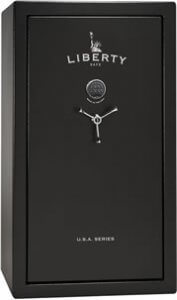
Liberty USA 30 RSC-I Gun Safe
Liberty is the largest manufacturer of gun safes. They are aggressive marketers and make some misleading claims that I’ve highlighted on other pages in this site. However, they are pretty good at customer service and stand behind their products better than most. Compared to many of their competitors, Liberty will give you less aggravation and usually respond faster. Because of this, they’re my first recommendation for best value RSC Level 1 gun safes.
Another benefit comes due to Liberty’s size. They are the largest domestic gun safe manufacturer. They’ve invested in serious infrastructure like robot welders for the body steel. Thinner-steel gun safes are harder to weld. Therefore, cheap gun safes benefit the most from better welding equipment, as discussed in the welds section. Robot welders enable Liberty to keep prices low on their low-end units while maintaining consistent built quality.
Liberty Centurion (Not RSC)
For several years now, the Centurion has been made exclusively in the USA. Unfortunately its 14 gauge steel doesn’t meet the RSC-I construction requirements, which specify 12 gauge thick body steel. Because these are not RSCs, you’re probably better off stepping up to the USA Series (below), or going with a gun safe alternative.
The 14 gauge Centurion is perfect, though, for a cheap decoy gun safe. The base models have a UL listed S&G 6741 mechanical dial lock.
The current Centurion comes in 12, 18, and 24-gun sizes. Current production Centurions do not meet the UL RSC requirements, but are approved by the California DOJ. The current production “American made” Centurions are priced from $550 to $950 depending on size.
Liberty USA / Revere (RSC Attack Level 1)
The next step up from the Centurion is Liberty’s USA Series, which are RSC-I listed. They now come in 30, 36, and 48-gun sizes. There was a 23-gun size which was discontinued but you may still see them around. These are made in the USA with 12 gauge steel.
The USA line replaced the Revere line. Revere’s, like the RV23 and RV30, have always been American-made gun safes, and are equivalent to the USA Series. If you come across a “RV20” on the used market, note that they were made in both USA and China.
The American-made Liberty USA models start at around $1,200 for the USA-30 up to $1,500 for the USA-48. These Liberty USA models are a best value gun safe.
Liberty has a wide dealer network. A lot of gun shops carry Liberty, and cheap gun safes are easier to handle and install yourself. So, they’re a great opportunity to support your local gun shop by buying one locally. You can also buy online from Liberty, or other vendors.
Other Good RSC Attack Level 1 Gun Safes
Liberty isn’t the only company that makes a good RSC-I gun safe. Browning, Dakota, and American Security (AMSEC) also have respectable budget gun safes (RSC-I).
Remember that RSC Level 1 only offers protection from modest hand tools. So, when shopping for a cheap gun safe, just look for the lowest price properly-made RSC-I with the options you want. Don’t spend money on RSC-I “upgrades”.
The models in the next category start at $1,850 without fireproofing and are significantly more resistant to common attacks (more than small hand tools).
For most people burglary risk is about 5X higher than fire, and you can improvise your own fire protection. So, skipping fireproofing to get more burglary protection usually makes more sense than getting minimal protection for both.
If you don’t have the cash right now, consider buying a toolbox or other option for now. Then save up for an *Exceptional Gun Safe (~RSC Level II) with fireproofing.
Best Gun Safe for the Money – *Exceptional Gun Safe (RSC Attack Level 1 to 2)
Although there isn’t much difference in the security of RSC Level 1 compared to a true safe, there are a few that are worth your consideration. Starting in 2018, there is also a RSC Level 2.
If you are looking in this price range, you should definitely take a look at these models. All are American made gun safes.
Readers email me about this-or-that brand of gun safes. Before emailing me about a particular model, please take a minute and compare it to the specs in the table below. You probably won’t get past the 2nd or 3rd row before realizing that the gun safes below give you more bang for your buck. Also, if you’re having trouble finding the specifications from another manufacturer, that isn’t a good sign! BTW, another article has a full list of gun safe evaluation criteria.
Sturdy Gun Safe vs. American Security (AMSEC) BFX/BFII Gun Safe Review
Below is a gun safe comparison table. Each category and my scoring are explained in detail under the table.
| Specification | Sturdy | AMSEC BFX & BFII | Winner |
|---|---|---|---|
| Security Rating | Exceeds but not Tested UL 1037 Attack Level 1 Residential Security Container | UL 1037 Attack Level 1 (BFX) or Attack Level 2 (BFII) Residential Security Container | AMSEC BF / Tie (Standard) AMSEC BFII (Optional) |
| Standard Steel, Door Outer Sheet | 5/16" (0.3125") (Standard) 3/8" (0.3750") + 3/16" (0.1875") Steel/Stainless Reinforcement (Optional) | 1/2" (0.5000") (BFX except below models) 3/8" (0.3750") (BFX6024, BFX7250) 1/2" (0.5000") (BFII) | AMSEC (Standard) Tie (Optional) |
| Standard Steel, Walls Thickest Sheet | 7 gauge (0.1793") (Standard) 4 gauge (0.2242") + 3/16" (0.1875") Steel/Stainless Reinforcement (Optional) | 11 gauge (0.1196") Outer (BFX) 4 gauge (0.2242") + 12 gauge (0.1046") Inner (BFII) | Sturdy (Standard) Sturdy/Tie (Optional) |
| Body Welds | Continuous | Continuous | Tie |
| Anchor Holes | (2) 5/8" with Tubing Guides (Standard) Additional $25/Ea. | (4) Anchor Holes | AMSEC (Standard) Tie (Optional) |
| Door Hinges | Exterior, Right or Left | Exterior, Right or Left | Tie |
| Door Seal | 3M intumescent caulk and fiberglass boiler gasket, Full Length | Palusol intumescent seal and silicone seal, Full Length | AMSEC |
| Lock Types | Dial (Standard) Electronic Keypad, Dual Locks in Series (Optional) | Dial (Standard) Electronic Keypad, Key Lock, Dual Locks in Parallel for BF's Only (Optional) | Tie (Standard) AMSEC (Optional) |
| Lock Rating, Mechanical Dial | UL 768 Group 2 (Standard) | UL 768 Group 2 (Standard) | Tie |
| Lock Rating, Electronic Keypad | UL 768 Group 1 (Optional) | UL 768 Group 1 (Optional) | Tie |
| Combination Lock Manufacturers | S&G 6730 (Standard) S&G D-Drive and Dual Locks (Optional) | AMSEC (Standard) S&G, La Gard, Kaba Mas (Optional) | Sturdy (Standard) AMSEC (Optional) |
| Bolt Work | Bar Steel with Sheet Metal | Sheet Metal (BFX) TL-15/30 Bolt Work (BFII) | AMSEC BFX (Standard) AMSEC BFII (Optional) |
| Shear Pins or Clutch Mechanism | No | No | Sturdy / Tie |
| Fire Rating | No Recognized Rating (Fire Protection is Optional) | No Recognized Rating (Based on UL 72 Class 350 1 Hour design) | AMSEC / Tie |
| Fire Insulation Type | (Optional) 2.5" Ceramic Wool +1~2" Fiberglass (door, top, floor) | Poured "DryLight" Concrete Amalgamate | AMSEC |
| Fire Insulation Thickness | (Optional) 2.5" to 4.5", slightly compressed | 1" door, 2" walls | Sturdy / Tie |
| Steel Inner Fire Liner | 16 gauge (0.0598") | 12 gauge (0.1046") (BFX Body) 4 gauge (0.2242") + 12 gauge (0.1046") (Body), 11 gauge (0.1196") (Door) (BFII) | AMSEC BF (Standard) AMSEC BFII (Optional) |
| Made In | USA | USA | Tie / Sturdy |
| Cosmetic Features | Few, utilitarian | Chrome/brass/black nickel 5 spoke bolt wheel, pull handle, and logo. Polished interior back wall | AMSEC |
| Interior Electrical Connection | Hole Only (Optional) | Standard | AMSEC |
Sturdy Safe Models

Sturdy 2419 with Alyssa
Sturdy takes a no-nonsense approach to its gun safes. Their products are pretty much perpendicular to the rest of the RSC gun safe industry. Sturdy does not have many cosmetic options. Instead, their products emphasize thick steel and simple robust bolt work and construction. This makes them much stronger than the vast majority of RSC-I gun safes.
Sturdy prides itself on manufacturing as much as possible in the United States, and even sourcing only American materials where they can. Sturdy is a small family owned business, owned by Terry, his wife Toni, and daughter Alyssa. Terry is in many of the videos on Sturdy’s website and YouTube and sometimes even answers the phone. Alyssa is the webmaster and frequently responds to questions and comments on gun forums.
Sturdy safes are sold factory direct to keep costs low. Sturdy’s safes are available in nine different standard sizes, in addition to custom sizes and options.
One unique feature is that Sturdy’s gun safes are available with or without fireproofing. More on this below. This can save you money that you can use to implement fireproofing alternatives.
| Sturdy Standard Models | Outside Height {in} | Outside Width {in} | Outside Depth {in} | Starting Weight, w/ Fireproofing {lbs} | Starting Weight, No Fireproofing {lbs} |
|---|---|---|---|---|---|
| 2419 | 60 | 24 | 19 | 615 | 520 |
| 2822 | 60 | 28 | 22 | 775 | 630 |
| 3224 | 60 | 32 | 24 | 850 | 680 |
| 3224-6 | 72 | 32 | 24 | 980 | 800 |
| 3627 | 60 | 36 | 27 | 950 | 780 |
| 3627-6 | 72 | 36 | 27 | 1,085 | 900 |
| 4227-6 | 72 | 42 | 27 | 1,485 | 1,220 |
| 4827-6 | 72 | 48 | 27 | 1,160 | 955 |
| 6028-6 | 72 | 60 | 28 | 1,600 | 1,270 |
Sturdy’s smallest standard model 2419 starts at $2,300 with fireproofing, or $1,900 without. Sturdy’s largest standard model is the 6028-6. It starts at $6,000 with fireproofing, or $5,000 without. Click on the part numbers in the table above to see Sturdy’s product page with pricing for each model.
American Security Gun Safes, BF Models
American Security or AMSEC is a much larger company with around 1,000 employees. A significant portion of their product offerings are cheaply made and sourced from China. They also make RSCs, which are different from these models. However, AMSEC’s higher end products are made in the USA. These include a range of true safes, and even the only UL 687 TL-30X6 rated gun safe available. For more info, see my article about true safe ratings like UL687 TL-30.
The BF (Burglary & Fire) line split into two segments, which can be confusing.
AMSEC BF True Safes
AMSEC’s BF true safes are smaller, jewelry safe sized units. All of these units (BF1512, BF1716, BF2116, and BF3416) have both B-Rate construction and a UL 72 Class 350 Fire Endurance Rating. An explanation of these true safe burglary ratings and fire ratings can be found by clicking those links.
Fire endurance ratings for BF1512, BF1716, and BF2116 are UL72 Class 350 listed for 1 hour, while the largest BF3416 is listed for 30 minutes. The safe walls have 2-3/8″ thick poured concrete amalgamate fireproofing.
AMSEC BFX Gun Safes
The BF true safes above are similar to, but should not be confused with, AMSEC’s BFX gun safes. Note the 2019-and-earlier “BF” gun safes are identical to the 2020-and-later “BFX” except for the lockwork and weight (see below).
The BFX Gun Safes (BFX6024, BFX6032, BFX6030, BFX6636, BFX7240, and BFX7250) are larger and does not carry the same ratings as the smaller BF true safes. BFX gun safes have thinner steel and fireproofing, probably to save weight.
Even though the BFX gun safes have reduced steel and fireproofing compared to the BF true safe versions, they’re no slouches. In fact, the AMSEC BFX gun safes are the only current RSC-I gun safes constructed using the same materials and techniques as (the vast majority of) commercial fireproof true safes. More details about this can be found below.
AMSEC BFII Gun Safes
UL added two levels to the RSC Standard in late 2016. In 2018 AMSEC debuted the world’s first UL RSC Attack Level 2 listed gun safe, the BFII.
BF-HD units had been part of the AMSEC 2017-2018 Product Catalog, but were discontinued in the second half of the catalog’s period. The supplemental American Security 2018 Gun Safe Catalog debuted the BFII.
As you can see from the table below, all BFII units are heavier than their BF-HD equivalents, as they contain more steel. Given how price sensitive the gun safe market is, you can bet the additional steel was not added capriciously.
| AMSEC BF Standard Models | Outside Height {in} | Outside Width {in} | Outside Depth {in} | Weight, w/ Fireproofing {lbs} |
|---|---|---|---|---|
| BF6024 (Discontinued) | 59.25 | 24 | 21 | 720 |
| BFX6024 | 59.25 | 24 | 21 | 751 |
| BF6024HD (Discontinued) | 59.25 | 24 | 21 | 893 |
| BFII6024 | 59.25 | 24 | 21 | 1,067 |
| BF6032 (Discontinued) | 59.25 | 30 | 21 | 913 |
| BFX6032 | 59.25 | 30 | 21 | 958 |
| BF6032HD (Discontinued) | 59.25 | 30 | 21 | 1,118 |
| BFII6032 | 59.25 | 30 | 21 | 1,244 |
| BF6030 (Discontinued) | 59.25 | 30 | 26 | 1,036 |
| BFX6030 | 59.25 | 30 | 26 | 1,081 |
| BF6030HD (Discontinued) | 59.25 | 30 | 26 | 1,244 |
| BFII6030 | 59.25 | 30 | 26 | 1,395 |
| BF6636 (Discontinued) | 65.25 | 36 | 26 | 1,319 |
| BFX6636 | 65.25 | 36 | 26 | 1,375 |
| BF6636HD (Discontinued) | 65.25 | 36 | 26 | 1,601 |
| BFII6636 | 65.25 | 36 | 26 | 1,716 |
| BF7240 (Discontinued) | 71.25 | 40 | 26 | 1,585 |
| BFX7240 | 71.25 | 40 | 26 | 1,647 |
| BF7240HD (Discontinued) | 71.25 | 40 | 26 | 1,923 |
| BFII7240 | 71.25 | 40 | 26 | 1,991 |
| BF7250 (Discontinued) | 71.25 | 50 | 26 | 1,789 |
| BFX7250 | 71.25 | 50 | 26 | 1,851 |
| BF7250HD (Discontinued) | 71.25 | 50 | 26 | 2,204 |
| BFII7250 | 71.25 | 50 | 26 | 2,438 |
AMSEC’s smallest standard model BFX6024 starts at around $3,700. AMSEC’s largest standard model is the BFX7250. It starts at $7,100. The BFII versions start at $4,300 for the BFII6024 up to $8,200 for the BFII7250. Click on the part numbers in the table above for online pricing for each model.
There have been a few changes to BF gun safe line over the years:
- Until 2010, the BF gun safe poured fireproofing was formulated to offer mostly fire protection. The walls had 10 gauge outer and 14 gauge inner steel fire liner shells. Starting in 2010, AMSEC’s proprietary “DryLight” concrete amalgamate mixture was changed, making it heavier and somewhat stronger. It’s not clear whether this change was made to standardize the BF gun safe with the rest of the AMSEC line, to reduce sensitivity to volatile steel prices, or for other purposes.
- 2010 and later BF gun safes have thinner steel in the walls but somewhat stronger concrete mixtures.
- Older BF gun safes don’t have top locking bolts.
- In 2015, AMSEC introduced the HD option for BF gun safes. This option replaces the 16 gauge (0.0598″) inner steel fire liner with 3.7X thicker 4 gauge (0.2242″) steel. The inner steel fire liner is then the thickest layer. More on this below.
- In 2018, steel fire liners for both the BF and BFII were increased from 16 gauge (0.0598″) to 12 gauge (0.1046″).
- In 2018, AMSEC replaced the HD option with the BFII series, which are UL RSC Attack Level 2 listed. All BFII units are heavier than their HD predecessors. Instead of BFII’s replacing the inner steel fire liner with 4 gauge (0.2242″) steel, the additional steel is added inside the BF’s 12 gauge (0.1046″) fire liner. BFII’s also switched to the higher rated AMVAULT TL-15 5-active-bolt pattern.
- In 2020, the BF series was replaced with the BFX series, which has improved lockwork resulting in noticeably higher weight.
Security Rating
Sturdy safes easily exceed the UL 1037 Residential Security Container construction specifications, but aren’t actually tested. Sturdy explains that they do this to pass on as much savings to their customers as possible.
AMSEC BFX gun safes are tested to UL 1037 Attack Level 1 Residential Security, and UL Listed for that rating. AMSEC BFII models are the first gun safes listed for the UL 1037 Attack Level 2 Residential Security (Edition 6, 2016).
For base models, AMSEC BFX gun safes of course wins this one, but the RSC-I rating is a pretty low bar in the world of safes. The RSC-II Performance Rating puts the AMSEC BFII into the league of true safes. The AMSEC BFII wins between upgraded models.
Standard Steel, Door Outer Sheet
As detailed in the what to look for article, steel is the most important specification for burglary protection.
Sturdy Safe Door Steel
Sturdy safes have standard 5/16″ (0.3125″) steel in the outer door sheet. This is much thicker than the vast majority of RSC-I gun safes.
Sturdy has increased their upgrade options for door steel. These include different configurations of stainless steel, which is more tool and torch resistant:
- 3/8″ (0.3750″) steel for the door outer sheet continues to be one option.
- Along with 3/8″ door steel, a new option welds another 3/16″ (0.1875″) steel sheet inside the door.
- The 3/16″ inner reinforcing sheet can be upgraded to stainless steel.
- Another option on top of the others welds a 8″ x 12″ sandwich of two sheets of 3/16″ (0.1875″) stainless to the lock area.
AMSEC BFX/BFII Door Steel
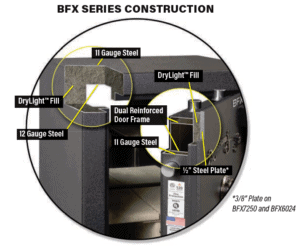
AMSEC BFX Gun Safe Construction Cutaway
The AMSEC BFX gun safes have 1/2″ (0.5000″) outer steel plate in the door, except for two BFX gun safe models. The smallest BFX6024 and largest BFX7250 models have 3/8″ (0.3750″) steel plate in the door. This is probably to save cost and weight, respectively.
All AMSEC BFII models have 1/2″ (0.5000″) outer door steel plate.
The inner fire liner alone of the BFX and BFII doors is 11 gauge (0.1196″), thicker than the walls of most RSC-1 gun safes. In addition, the BFX’s 1″ concrete amalgamate poured into the door behind the steel offers some additional protection against attack, discussed below.
Sturdy vs AMSEC BFX/BFII Door Steel
In terms of base option steel, AMSEC BFX wins. With all the options things get more complicated.
For Sturdy’s 3/8″ + 3/16″ steel option, the combined thickness is 9/16″ (0.5625″). One thick sheet of steel is stronger than a sandwich of two of the same combined thickness. However, these two sheets wind up thicker than the standard BFX’s 1/2″ (0.5000″) plate. Also, unlike most gun safes, there isn’t a weak layer of drywall between the sheets, and the BFX’s fire liner is 11 gauge (0.1196″), thicker than most gun safes.
Given Sturdy’s option of adding stainless steel reinforcement to the lock and/or door, vs AMSEC’s 0.6196″ of total door steel with concrete composite, I’ll call this one a tie.
Standard Steel, Walls Thickest Sheet
Sturdy Safe Wall Steel

Sturdy gun safe standard steel reinforcement options. White areas are available in 7 or 4 gauge (except the door, which is thicker). Orange areas are reinforced with 3/16″ steel sheet. Blue areas are reinforced with one or more layers of 3/16″ stainless steel.
Sturdy’s standard 7 gauge (0.1793″) steel outer body walls are thicker than the majority of RSC-I doors. 4 gauge (0.2242″) steel is optional on the body. In the diagram shown here, the outside steel thickness shown in white can be 7 or 4 gauge.
Augmenting one side or area of a Sturdy has long been an option. Sturdy has since standardized some of their most popular reinforcement configuration. Since these options add steel to only part of the gun safe, they are attractive for those with corresponding weight or cost budgets.
Two options involve welding 3/16″ sheet to both the side walls and door jamb, made of either steel or stainless steel. These are commonly attacked areas, so if you’re going to have more metal, they’re good places to have it. Of course, if you don’t bolt your gun safe down, your extra money could be wasted.
The Magnum Steel Package similarly adds steel to the sides and jamb, and then also to the top and back. The Sturdy Signature Package does the same as the Magnum, but the side reinforcement is upgraded to stainless. Another option reinforces the sides, jamb, and door with stainless.
AMSEC BFX/BFII Wall Steel
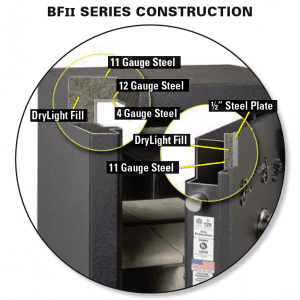
AMSEC BFII Safe Construction Cutaway
AMSEC BFX’s walls have 11 gauge (0.1196″) outer steel shells plus 2″ of concrete amalgamate fireproofing. The BF’s inner walls have another 12 gauge (0.1046″) sheet of steel.
The BFII seems to be constructed the same as the BFX, and then 4 gauge (0.2242″) of additional steel is welded inside the 12 gauge (0.1046″) fire liner. Coincidentally, that is exactly the same thickness Sturdy has been offering as a body steel upgrade.
Typically I would consider the inner steel below in the fire liner layer section. But since the BFII steel fire liner is almost three times as thick as the outer shell, it deserves to be covered here.
Thickening the inner steel layer has benefits for security of course, but also for fireproofing which are discussed below.
Sturdy Save vs. AMSEC BFX/BFII Thickest Sheet of Wall Steel
Sturdy gives the options for 0.4117″ in total body steel, including a stainless layer. The BFII option gives you 0.3288″ in inner wall steel, so strictly speaking Sturdy wins the thickest steel “sheet” comparison, too. The BFII, though, has 0.4334″ in total body steel, with a 2″ sandwich of concrete amalgamate, so it’s a draw.
Anchor Holes
Sturdy safes use tubing guides on their 5/8″ diameter anchor holes to prevent crushing of the non-structural fire proofing. Unfortunately though they only install two anchor holes on their standard gun safes. They’ll add more for $25/ea.
AMSEC’s BFX gun safes come with four pre-cut anchor holes.
AMSEC BFX gun safes wins this one in terms of standard configuration, although for $50 you can get four total anchor holes in your Sturdy.
Door Seal
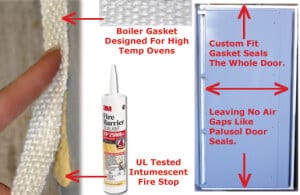
Sturdy Door Fire Gasket showing construction. They no longer use 3M products (see text).
For the door seal, Sturdy uses fire barrier intumescent (fire-expanding) caulk covered with a fiberglass boiler gasket. This choice may have been made to save money over the name brand Palusol door seal. They claim it’s rated for 4 hours instead of 1 hour for Palusol.
AMSEC BFX’s use a Palusol intumescent door seal. The door jamb also has a high temperature silicone seal. At the request of a reader, here’s a detailed analysis.
Fire Caulk vs. Intumescent Safe Door Seals
Sturdy’s graphic (above) shows a tube of 3M CP 25WP+ fire stop caulk, but that caulk is red in color. The yellow caulk shown in the same graphic looks more like 3M IC 15WB+. I confirmed with Sturdy that this is what they used on older models. However, Sturdy had problems with IC 15WB+ coming out lumpy and not adhering well, so they have since switched to STI LCI300, which is red.
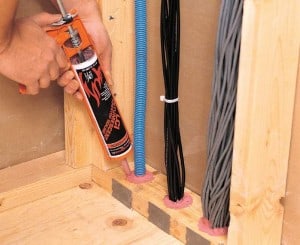
STI LCI300 Intumescent Caulk Installed as a Fire Stop
These 3M and STI products are intumescent fire barrier caulks. They are designed to be applied to holes in walls and floors around pipes and wires. In the event of a fire, they keep flames and smoke from passing through the holes. This application has a couple differences compared to an intumescent door seal.
Fire barrier caulks are designed to stick to both the inside (pipe/wire) and outside of a hole. Of course, this would glue a gun safe door shut. The boiler gasket used by Sturdy on top of the caulk is probably intended to keep the door from sticking to the caulk. In comparison, intumescent door seals are solids instead of liquids, avoiding this issue.
Fire barrier caulks don’t have to expand as much as intumescent door seals. By fire code they must be installed so that they take up all of the gap, as you can see in the picture. Intumescent door seals on the other hand must fill up the entire empty gap between the door and jamb. BASF Palusol and 3M’s similar Expantrol intumescent door seals expand 6X and 10X respectively. By comparison, 3M fire barrier caulks IC 15WB+ and CP 25WP+ expand only a minimum of 3X. Sturdy’s latest seal STI LCI300 is better in this regard, expanding a maximum of 8X.
The most important difference between intumescent door seals and caulks is expansion temperature. Intumescent door seals must expand as quickly as possible to fill the door gap and keep smoke and hot gasses out of your gun safe. Expansion must happen at relatively low temperatures because the door seal isn’t exposed to open flame. Also, the door is much cooler at the bottom.
Palusol starts to expand at only 212 °F, and is fully expanded by 482 °F. This is in line with the performance required to protect guns. The downside is that Palusol is sensitive to moisture, which is why it is installed wrapped in plastic. Expantrol doesn’t have humidity sensitivity but also doesn’t begin expanding until 392 °F; it’s fully expanded by 536 °F.
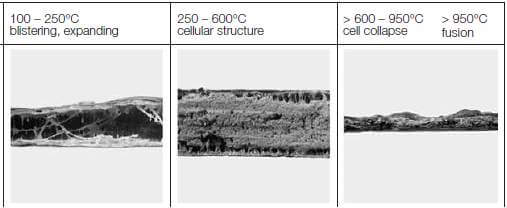
BASF Palusol Expansion. Note temperatures are in Celsius, not Fahrenheit.
Intumescent caulks may directly contact flames. They also are installed to seal holes and so don’t have to expand to fill gaps and block smoke. So, they generally are formulated from materials which expand at higher temperatures, making them more resistant to direct flames. 3M fire barrier caulks IC 15WB+ and CP 25WP+ don’t promise 3X expansion until 1000 °F! STI LCI300 doesn’t publish its expansion temperature. Judging by the application, it could be equally high.
To be used in building construction, intumescent caulks must be independently tested to ASTM E814 (UL 1479 Through-Penetration Firestop Systems) and/or ASTM E1966 (UL 2079 Tests for Fire Resistance of Building Joint Systems). There is no similar test for intumescent door seals. The intumescent caulks are rated to stop fire for 3 or 4 hours when, for example, installed between a copper pipe and concrete hole. However, this doesn’t mean it will keep smoke and fire out of your gun safe for 4 hours. While not quite an apples and oranges comparison, it is apples and pears. I found no 1 hour limit for Palusol’s fire resistance. It does starts to break down at 1112 °F, regardless of the duration, but doesn’t seem limited to 1 hour.
Sturdy Safe vs AMSEC BFX/BFII Door Seal
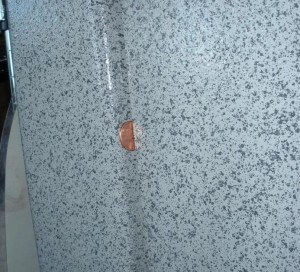
Penny showing typical Sturdy Safe door gap. Tight gaps help intumescent gaskets seal better at lower expansion.
This one goes to AMSEC BFX gun safes. Palusol is the industry standard because it’s specifically designed to seal fire doors and fire safes. It starts to expand at the lowest temperature of competing products. Also the AMSEC BFX has an additional high-temp silicone seal to help control gun safe moisture and provide additional protection in a fire.
Like AMSEC, Sturdy maintains tight door gaps which are a big help in sealing. Sturdy’s intumescent caulk has performed favorably in fires. However, no testing has been performed to establish whether Palusol would have worked better in those fires. Palusol is sold in strips which are cut to length, so there’s also no variation in caulking bead width which could happen with Sturdy’s gasket.
Lock Types
Sturdy Safe Lock Types
Sturdy offers a standard mechanical dial combination lock, or an electronic keypad as an option.
They also offer dual-locks “in series” with either two mechanical dial locks, or a dial and an electronic keypad lock. In dual-lock options, both locks must be unlocked to open the door.
AMSEC BF/BFII Lock Types
AMSEC offers a standard mechanical dial combination lock. As options, they offer electronic keypad and key locks.
On the BF gun safes, but not the BFII’s, AMSEC also offers “redundant boltwork” with dual-locks in parallel. With AMSEC BF’s dual locks, either lock can open the door.
To prevent confusion, let’s explore dual-locks a little more.
Safe Dual-Lock Types
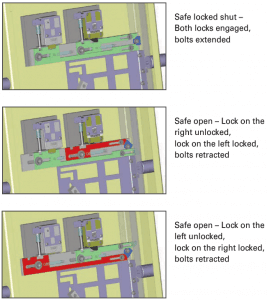
AMSEC BF Gun Safe Two Lock Redundant Boltwork – Either lock will open the BF gun safe.
Personally I would find it useful to have an electronic keypad lock with a mechanical dial as a backup. Electronic keypad locks have comparatively short lifespans. If it failed, the backup mechanical lock could save the cost of drilling open the safe.
This configuration would require that either lock could open the safe by itself. To use an electrical analogy, the locks are in parallel (Lock A OR Lock B) rather than series (Lock A AND Lock B).
“Parallel” is how AMSEC’s BF dual-lock option works. Sturdy’s “series” dual-lock configuration requires that both be opened.
Since each lock has a separate combination, Sturdy’s configuration would be useful if you wanted two different people to be present to open the gun safe.
Theoretically series locks could increase security. However, despite what Hollywood may believe, picking UL 768 safe locks isn’t common. (Click here and scroll down for a list of common gun safe attacks.) So, adding a second lock probably won’t stop a burglar.
What is common is lockout due to either failure of electronic locks, or forgetting/losing the combination. Putting two locks in series actually increases the odds of lockout by combining those failure and fault rates. The upside is that series dual-locks do not reduce the reliability of the bolt work.
I’d speculate that Sturdy chose the serial dual-lock configuration for that reason, since they offer a lifetime boltwork warranty. Also series dual-locks are straightforward to implement. UL 768 safe locks are effectively deadbolts. For series dual-locks, each lock separately obstructs the boltwork from retracting the bolts.
By comparison, parallel dual locks do increase the complexity of the bolt work, as you can see by the AMSEC image above. It is not trivial to design a strong, reliable linkage which opens when either of two deadbolts retracts. AMSEC has been designing boltwork for true safes for a long time, so they certainly know how to do it. However, since bolt work is another common gun safe failure area, this isn’t a small consideration.
Note that the higher-end AMSEC BFII model is not available with dual-locks. An AMSEC representative was asked on ar15.com why the BFII isn’t (currently) available with redundant boltwork. He indicated that “If the demand builds, we will consider it, but it’s a big investment to test at UL. We have to sell a lot of safes with [redundant locking bolts] to invest $20k in testing costs.”
Bolt work for each model is discussed below.
Sturdy Safe vs AMSEC BFX/BFII Lock Types
Both manufacturers offer standard mechanical dial locks.
Sturdy offers Electronic Keypad locks. AMSEC does as well as well as key locks.
Sturdy offers a dual-lock setups, but in a serial configuration that may not be that useful. AMSEC offers a more useful dual-lock configuration which curiously isn’t available on the higher-end model and complicates the boltwork. Given the additional options, AMSEC wins the optional lock types.
Lock Rating, Mechanical Dial
Both models come standard with UL 768 Group 2 mechanical dial combination locks. Click here for info on gun safe locks and ratings.
Lock Rating, Electronic Keypad
Both models come with optional UL 768 Group 1 electronic keypad combination locks.
Combination Lock Manufacturers
Standard Lock
Sturdy’s standard lock is the S&G 6730 industry workhorse mechanical dial combination lock.
AMSEC’s standard option is an AMSEC brand lock.
Winner for standard locks is Sturdy.
Optional Lock
Sturdy offers an optional S&G D-Drive electronic keypad combination lock.
AMSEC’s first electronic keypad lock option for the BFX gun safe is the AMSEC ESL10XL. This is one of 14 factory options for electronic keypad locks from AMSEC, S&G, La Gard, and Kaba Mas. They also have 3 options for UL Listed key locks.
AMSEC BFX gun safes offer a far wider variety of optional locks.
Bolt Work
Sturdy Safe Bolt Work
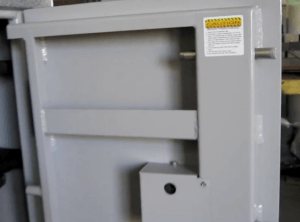
Sturdy Door Locking Bolt
Sturdy prides itself in its simple, robust bolt work. The four locking bolts are 7/8″ (0.875″) round bar steel which slide back and forth in a 3/16″ (0.1875″) thick, 4.75″ wide steel ‘C’ channel.
The second pry attack video in 11 Myths about Gun Safe Theft Protection showed a Sturdy. This unit had only the middle 2 locking bolts installed. Yet the video showed it resisting a pry attack that will open most RSC-I’s in less a minute or two.
Hinge side bolts are fixed, as they should be. The top and bottom door reinforcement protrudes on the hinge side to function as even stronger fixed locking bolts. The rigidity of this locking bolt frame adds strength to the Sturdy’s door despite the thinner (than the AMSEC) outer door steel. The Sturdy’s enclosed bolt work is more difficult to lubricate and service, but seems to hold up pretty well.
AMSEC BF/BFII Bolt Work
Like Sturdy, AMSEC’s hinge side bolts are fixed. Their BF locking bolt carriage however is constructed out of bent and stamped sheet steel. The bolt work shown in an image in Building an AMSEC BF Gun Safe shows that the bolt carrier is bent sheet metal, although it is thicker than the bolt carrier of most RSCs. The stronger the door and frame, the easier it is for the bolts to hold the door closed in an attack. The thicker steel on the BF door strengthens the bolt carrier, taking stress off of the bolt work.
The BFII boltwork however is a different animal. BFII models share their basic boltwork with AMSEC’s TL-15 and TL-30 true safes. The RSC-II is effectively a TL-10×6 rated safe.
Sturdy Safe vs AMSEC BF/BFII Bolt Work
For standard models, I’m scoring this one a tie.
The simplicity, reliability, and strength of the Sturdy are arguably preferable. Because the AMSEC’s door has a 1/2″ steel plate outer shell, it will not deform like a typical sheet metal RSC-I door in a pry attack. AMSEC makes lots of true safes and knows how to make lock work.
The BFII bolt work is the winner for optional models. It’s adapted from true safes.
The warranties may show some relative confidence each company has in its bolt work. AMSEC’s locking mechanism is warrantied for only 1 year, but Sturdy’s is warrantied for a lifetime.
Shear Pins or Clutch Mechanism
Sturdy points out frequently that their bolt work does not have shear pins or clutches. In this video owner Terry uses a pipe wrench and pipe for leverage to put a tremendous amount of torque on the bolt handle shaft.
AMSEC is less forthcoming about the construction of their BF gun safe bolt work, but it doesn’t look like they have clutches. AMSEC advertises “slip clutches” as a “feature” in their lower end FV and TF gun safes, but doesn’t mention these clutches for the higher end BF and SV. Because AMSEC sells low end products with clutches, they probably refrain from mentioning the downside of clutches because that might hurt sales of their low-end products.
Although AMSEC BF gun safes don’t seem to have clutches or shear pins, I’ll give this one to Sturdy who both provides this information openly and publishes video of a handle attack.
Fire Rating
Sturdy’s fire protection is optional. Owners who want to save money and get more interior space may elect to get a Sturdy without fire protection. Sturdy has commented on forums that they haven’t attempted UL 72 testing because they work to minimize costs and the testing is expensive.
Because the fire lining of the AMSEC BFX is structural, this gun safe is not available without fire protection.
Technically neither model has a recognized (UL 72) fire rating so this is a tie. AMSEC’s design and construction however is based on the BF true safe which carries a UL 72 Class 350 rating, so it has an edge in this category.
Fire Insulation Type
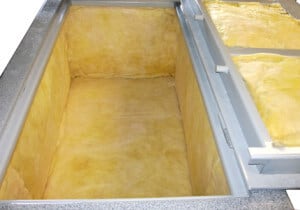
Sturdy Installing Fireproofing (inner layer)
Sturdy’s fireproofing is an outer layer of 2300 °F rated Ceramic Wool and an inner layer of 1000 °F Fiberglass. This strategy uses insulation (high thermal resistance) rather than water to steam phase changes as protection. This type of insulation is typical on high temperature ovens to keep heat in over long periods of time.
Sturdy’s insulation is much much lighter than poured concrete-based fire lining. This makes moving it easier, and cheaper. If your installation location is sensitive to weight, this is a huge benefit.
One downside of Sturdy’s insulation is that it offers no structural support or burglary protection. Stronger steel supports are required between the inner and outer shells to support the contents of the gun safe. These steel supports can transfer heat in a fire.
Also Sturdy’s method of fireproofing is not very common. It’s only used in about 1% of UL 72 fire safes. Typical UL 72 fire safes use a poured outer fire lining to hold the interior temperature in a fire to under 350 °F. Then there is a steel inner shell to block humidity. Ceramic wool is used as the inner insulation on UL 72 Class 125 fire safes to keep the temperature under 125 °F at low humidity.
AMSEC calls its proprietary poured concrete amalgamate fireproofing “DryLight”. People who have handled the post-2010 material in cutaways describe it as having the consistency of cured tile grout. It fully adheres to the steel walls.
Formerly, AMSEC avoided mentioning that the same DryLight fill is used in the BF gun safes as the UL 72 fire safes. Now however, AMSEC advertises it.
AMSEC BF gun safes win this one. Poured concrete amalgamate is the predominant material used in fireproofing commercial burglary and fire rated safes. If you’re looking for lightweight fire protection though, the Sturdy has the advantage.
Fire Insulation Thickness
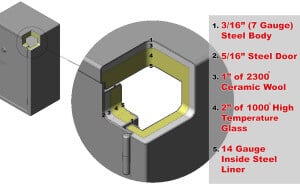
Sturdy Gun Safe Fireproofing Cutout. Fireproofing thicknesses have been changed.
Sturdy’s fireproofing is layered with different thicknesses in different locations. The thicknesses have changed a little over the last few years, but have remained close to these specifications.
The entire Sturdy interior has a 2.5″ thick outer layer of 2300 °F ceramic wool. For the walls, this is the only layer, and it is compressed to 2.25″. Compressing insulation reduces some of the R-value (thermal resistance), but a quarter-inch isn’t the end of the world.
The roof, floor, and door also have another inner layer of fiberglass added. The roof and floor inner fiberglass layer is 2″ thick. The door inner fiberglass layer is 1″ thick.
AMSEC’s BF gun safe fireproofing is 2″ thick in the walls, and 1″ in the door.
Sturdy’s insulation is 25% to 100% thicker and layered, so technically it wins this category. Obviously though, this is an apples to oranges comparison.
Smaller BF true safe versions, with more steel and only 3/8″ thicker fireproofing, pass UL 72 Class 350. So, 2″ of DryLight offers significant protection.
With that said, to get the larger BF gun safes to pass UL 72 Class 350 would clearly take more than 2-3/8″ of insulation. Due to its larger size, the largest BF3416 true safe is only actually UL 72 listed for 30 minutes. The BF gun safes are much bigger that the BF3416, and so their fire rating would be lower than that.
The newer BFII gun safe option however throws a curve ball into the fire surviveability equation. BFII’s actually have more total steel in walls (0.4334″) than the BF true safe (0.2500″). In addition, 76% of the BFII wall steel is in the steel fire liner, inside the safe. This means the additional steel you’re buying actually adds fire resistance to the BFII gun safes.
For fire protection, you really want as much thermal mass (steel) inside the insulation as possible. In a fire, the heat then not only has to penetrate the fireproofing, but also heat up the heavy steel. If you think about a pot on the stove, the more water (thermal mass) in the pot, the longer it takes to boil. So, the BFII version of the BF gun safe brings it closer to UL 72 Class 350.
Steel Inner Fire Liner
Sturdy has reduced its inner steel fire liner from 14 gauge to 16 gauge (0.0598″). Coincidentally again, they changed it to the same thickness as the previous BF inner liner. Since the Sturdy fireproofing offers no structural support, the inner liner doesn’t really help with security. Also, it’s not included at all if no fireproofing is chosen. So, this was a wise place for Sturdy to cut costs.
The standard AMSEC BFX inner steel fire liner is 12 gauge (0.1046″). The BFII option adds another 4 gauge (0.2242″). The approximate 3X increase in thermal mass of the BFII steel fire liner actually helps in a fire. In both cases, the liner is adhered to a poured concrete amalgamate, which structurally supports the gun safe.
AMSEC wins this one.
Country of Manufacture
Sturdy manufacturers all of its safes in Fresno, CA.
AMSEC BF gun safes are made in Fontana, CA. AMSEC has many other product lines made in China.
Both gun safes are made In USA, but Sturdy has an edge with regard to the percentage of products made in the USA, and commitment to sourcing US materials.
Cosmetic Features
Sturdy safes are all business and have a utilitarian appearance. No cosmetic features like multi-spoke locking handles here. This appeals to a lot of their customers. It also makes Sturdy’s easier to camouflage as a storage or electrical cabinet. There are some paint options, but Sturdy’s are not beauty queens.
AMSEC BF’s have a more classic gun safe look. They’re available in 13 colors. 5 spoke bolt handles are available in chrome, brass, or black nickel. They also have large pull handles and raised logos in matching finishes. AMSEC BF gun safes have polished rear walls to help reflect interior light, increasing visibility.
AMSEC BF wins this category. However, Sturdy’s appearance has its benefits. Because almost every penny of a Sturdy goes into steel, these are a better choice if want to save money on cosmetics. The Sturdy is also a better choice if you’re going to hide or camouflage it.
As a testament to the value of a utilitarian appearance, AMSEC offers a gun safe cloak. So, after you’ve purchased all of those chrome trinkets, the cloak can help make your gun safe look like a wood cabinet!
Interior Electrical Connection
Sturdy’s optionally come with a 3/8″ hole drilled for running electricity into your gun safe. In the website picture it looks like the hole is also grommeted, which is important for safety. The electrical hole is automatically drilled if you order a Dri-Rod heater type dehumidifier from Sturdy. You’ll still have to supply your own cord, feed it through the hole, and install a plug or receptacle yourself.

AMSEC Interior Electrical Connection
AMSEC’s standard electrical connection is at the entire other end of the spectrum. Not only is an internal receptacle installed inside the gun safe, but the outside extension cord can be disconnect for moving. The cord can be seen in the images of Building an AMSEC BF Gun Safe.
AMSEC handily wins this contest. Sturdy’s electrical connection option is a little behind the times. The only benefit to the Sturdy configuration is if the actual hole drilled into the AMSEC for the electrical connection is bigger. Bigger holes present more of a fire risk.
Burglary Protection
Performance Ratings
Which unit offers better burglary protection? Great question. Both easily exceed the UL 1037 Attack Level 1 Residential Security Container requirements and meet the same Construction Ratings.
The Sturdy has not been independently security tested, and so has no Performance Rating. The AMSEC BFX has passed UL 1037 Attack Level 1 (RSC-I) testing, which does mean the design was reviewed by expert safe crackers. The AMSEC BFII is the first gun safe to meet the UL 1037 Attack Level 2 (RSC-II) Performance Rating, which is a significantly higher bar.
Construction Ratings
No part of the Sturdy safes meet the B-Rate true safe construction specifications. However, their design far exceeds most gun safes and is no slouch. In fact, with upgrades the total door steel thickness (0.5625″) exceeds the B-Rate 0.5000″ requirement, except that B-Rate safes require a single plate 1/2″ door. (Combined steel thicknesses are allowed in the B-Rate walls if they are concrete composite.) Even so, the 4 gauge (0.2242″) steel option brings the walls close to B-Rate. Optional reinforcement can bring it to 0.4117″ total thickness in critical areas. Stainless steel is yet another variable.
The 1/2″ plate steel door of the AMSEC BFX and BFII (excluding the smallest and largest BFX models) does meet the B-Rate true safe specifications. The standard body steel does not. However the BFII models rise to that specification.
The 7 gauge (0.1793″) steel shell of Sturdy safes is much thicker than the 11 gauge (0.1196″) outer shell of the AMSEC BFX gun safe. This is a big advantage for burglary protection between the base models.
Sturdy’s fireproofing offers no additional security for the body. For AMSEC BF gun safes, the wall strength of the 2″ composite sandwich of concrete amalgamate and steel depends on the strength of the proprietary DryLight mix. The relative wall strengths have been the source of gun forum discussion for some time. Especially because the security added by the fill depends on the type of attack.
Speaking of attacks, shortly after Sturdy published it, a reader commented with the video below. The video is worth adding to this conversation, as it compares blows with the pick of a fire ax.
The AMSEC BF gun safe attacked above has an 11 gauge (0.1196″) outer shell, 2″ of DryLight concrete amalgamate, and 16 gauge (0.0598″) inner steel fire liner. After this video, the BF inner fire liner was increased to 12 gauge (0.1046″), and so is stronger than the unit in the video.
If you haven’t read any of the other articles, the first takeaway of course is that steel is most important for burglary protection. Resistance to picks and axes is why my base recommendation for gun safe body steel is 10 gauge.
For comparison, here’s 21 vertical blows with the pick of a fire ax against thicker 10 gauge (0.1345″) steel from the theft protection article. This plate of course has no DryLight fill behind it.
How much strength is added by the fill? Hard to say from this comparison. Sturdy gun safes have more steel standard in the body. Steel is the best defense against a fire ax. That sharp pick neutralizes much of the potential strength benefit of the AMSEC BF fill. A bigger difference would be seen for impacts covering more surface area, and some types of power tools. For example, if Sturdy had turned the ax around to the blade side, the BF fill would have been a bigger help to the outer steel.
Don’t forget that Sturdy is not showing a door attack because standard AMSEC BF gun safes have more steel there. The door is a very common attack point, and its strength is critical to keeping the door closed in an attacked. AMSEC could respond with a video showing a power tool attacking both doors. AMSEC’s 1/2″ (0.5000″) plate door steel plus 1″ of fill, would be noticeably more resistant than Sturdy’s 5/16″ (0.3125″). There are also other attacks on the Sturdy (which I won’t mention here to protect gun owners) which the AMSEC would resist better.
While it’s useful to consider what scenario you want to protect against, you can get lost in these contingencies. Let’s cut to the bottom line.
Sturdy Safe Base Model vs AMSEC BFX Summary
To summarize the burglary protection:
- Sturdy Safe Base Model Gun Safe
- The standard Sturdy gun safe is sized to protect from against brute force attacks on all sides.
- Almost every penny and pound of its cost and weight budget goes into steel.
- It’s substantially more robust than most all RSC-I gun safes.
- Compared to true safes, Sturdy’s are designed with some clever but unconventional methods, and don’t always use the same materials. Those methods do have benefits for weight and cost sensitive applications.
- If you’re worried about brute force attacks, the Sturdy’s are a best gun safe for the money.
- AMSEC BFX Gun Safe
- The AMSEC BFX gun safe is constructed using the same basic methods as their high security true safes, with modifications. The construction is “scaled down” to somewhere between a RSC-I gun safe and a true/fire safe.
- The AMSEC emphasizes burglary protection for the door, and fire protection.
- Due to the cost and weight of the fireproofing, the body steel in the base AMSEC BFX gun safe is a bit of a compromise.
- Similarly, the fireproofing fill is a compromise for fire protection, and does not include strengthening or power tool resistant additives found in UL 687 safes (carbide, etc.).
- If your installation location location can take the weight, and blocks access to the sides and back of the gun safe, the BFX’s more robust door may be a better fit for you.
Sturdy Safe Upgrades vs AMSEC BFII Summary
Sturdy’s upgrades are beneficial, notably stainless steel. But Sturdy does rightly criticize the body of the BF for having multiple sheets of thinner steel, instead of one thick one. Ironically Sturdy’s upgrades are likewise composed of multiple thinner sheets of steel, instead of one thick one.
When the upgrades are compared, the AMSEC BFII has B-Rate Construction Rating, making it a true safe. It’s also the first gun safe to earn a RSC-II Performance Rating. This required even more steel than the solid BF-HD, and also adapting the boltwork from AMSEC’s TL-15/30 true safes.
The AMSEC BFII wins between the upgrades due to its door strength, construction methods, and RSC-II listing. It’s a new standard. This does come at a cost of price and weight. There are some applications where and upgraded Sturdy will be a better fit.
Incidentally, there are other options beside steel for protecting the walls of a gun safe. You can save money by putting it in an enclosed space, or you can building walls around it.
Fire Protection
The design of Sturdy’s fireproofing is relatively unique for a fire safe. They are constructed more like a high temperature oven than the vast majority of UL 72 Fire Endurance Rated safes. By all accounts, in home fires Sturdy safes seem to offer good protection. However, they have no recognized rating.
AMSEC BF gun safes are constructed the same way as commercial burglary and fire safes. In fact, the smaller BF true safe version with 39% more wall steel and 19% thicker wall fireproofing has a UL 72 Class 350 Fire Endurance rating. However, the largest BF3416 “jewelry safe” couldn’t meet the same 1 hour rating as its smaller brothers. So, it’s clear that the BFX gun safes couldn’t meet UL 72 Class 350, due to their larger size and thinner fireproofing. The BFII option has increased interior steel (thermal mass), actually more steel than its smaller true safe brothers. So, the BFII version may actually be closer to UL 72 Class 350.
“Back of the envelope” engineering calculations performed by a forum member show that the Sturdy fireproofing has many times higher thermal resistance (more heat insulation) than AMSEC’s. However AMSEC’s fireproofing is more than just insulation. Their concrete mixture has a high thermal mass and uses the phase change of water to steam to protect the inside of the gun safe in a fire. Either type could be more effective, depending on the implementation.
The only way to settle the fire performance debate is to do a direct comparison, or to compare the Sturdy to a UL 72 fire rated gun safe of similar size and construction. Unfortunately there aren’t any UL 72 fire safes of the same size similarly constructed to the Sturdy.
The Sturdy may very well offer better fire protection than the AMSEC BF gun safe. But, because the Sturdy’s fire proofing offers no direct comparison to a UL 72 listed fire safe, the AMSEC BF has the edge in fire protection.
If you’re looking for the best fireproof gun safe without stepping up to a true safe, both are better that most all gun safes (for reasons described here). But, I’ll give the AMSEC BF the edge, especially the BFII option.
Customer Service
Sturdy’s customers are generally happy with their customer service. They’re a small company that prides itself in satisfied customers. They are happy to customize your gun safe with whatever options you want.
AMSEC’s customer service is also well regarded. One safe tech reported that AMSEC had just replaced a vault door because the paint “wasn’t quite right”. A difference is that AMSEC’s size means calling them you’ll wind up talking to a customer service representative. These rep’s can give you misleading answers as they are not themselves safe experts.
Also like AMSEC, most manufacturers of high security safes are not forthcoming about technical specifications of their products. This is good, because a thief can’t just call and ask how a safe he saw in someone’s house is constructed. However, it means you should probably buy an AMSEC BF gun safe through a dedicated commercial safe dealer who is familiar with the products. He or she will have proprietary knowledge about its construction that is not released outside the safe industry for security reasons. Because customization is a distraction from AMSEC’s high volume production, they can charge a premium for customization that a safe technician may be able to do cheaper.
Bottom Line: Sturdy Gun Safe vs. American Security BF Gun Safe
Both are great choices. Each has a solid design. The designs have been relatively stable, except for their steel-upgrade-war over the last few years which benefits customers. You can’t go wrong either way, although one or the other may be better for your application as described above.
Did I miss anything? Let me know in the comments below.
Zanotti Armor Modular Gun Safe Review
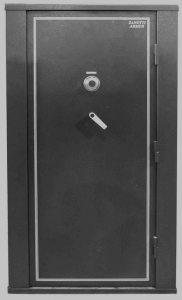
Zanotti Armor Z-3 5ft Modular Gun Safe
If you’re looking for a modular or take-down gun safe, Zanotti Armor makes the best modular gun safe.
Modular gun safes can be disassembled and reassembled, making them easier and cheaper to move. This makes them very popular with military personnel and others who relocate often.
Zanotti ships their gun safes in three or four flat boxes. The heaviest part is the door, which weighs 100 to 175 lbs depending on the size. Because of the manageable weight, only a hand dolly is needed to move the boxes.
These modular gun safes break down into five panels and the door. Panels are held together with pins, as shown in the video below.
Smaller models can be assembled by one person, but you’ll need a buddy for the big ones. Assembly takes about a half hour and requires only a rubber mallet, block of wood, and maybe a piece of EMT conduit or pipe.
To assemble a Zanotti gun safe, you only need access to the inside, as shown in the video. The back panel is installed from the inside, not the outside. This means you can put the safe together in a closet — even a tight one with walls against all 3 sides.
Blocking access to the walls and the gun safe in a closet will significantly increase security. In addition, if the gun safe is too large to tip over or fit through the closet doorway when assembled, apartment renters don’t have to worry as much about bolting it down.
| Specification | Zanotti |
|---|---|
| Security Rating | Exceeds but not Tested UL 1037 Residential Security Container |
| Standard Steel, Door Outer Sheet | 3/16″ (0.1875″) |
| Standard Steel, Walls Thickest Sheet | Top & Bottom: 3/16″ (0.1875″) Sides: 1/8" (0.1250″) Sides can be Customized with 1/8" Additional Steel |
| Body Welds | N/A Panel pins in double and single shear |
| Anchor Holes | 4 |
| Door Hinges | Exterior, Right or Left |
| Door Seal | No |
| Lock Types | Mechanical Dial Combination |
| Lock Rating, Mechanical Dial | UL 768 Group 2 |
| Lock Rating, Electronic Keypad | Discontinued (see below) |
| Combination Lock Manufacturers | La Gard 3330 |
| Bolt Work | Simple |
| Shear Pins or Clutch Mechanism | Shear Pin, 60 to 70 ft-lbs |
| Fire Rating | N/A |
| Fire Insulation Type | N/A |
| Fire Insulation Thickness | N/A |
| Steel Inner Fire Liner | N/A |
| Made In | USA |
| Cosmetic Features | 3 or 4 Paint Colors |
| Interior Electrical Connection | 5/16" Hole |
Door Construction
Zanotti gun safes have respectable 3/16″ (0.1875″) plate steel doors.
These are one of the few gun safes that you can order with a left-swinging door. Unless you’re left handed and like the convenience, that isn’t the biggest benefit for a modular gun safe. People that move often buy modular gun safes. A left-swinging door may be perfect for your current home, but not for the next five.
No door seal is included. Since each of the panels has seams, sealing the door is less of a benefit.
Body Construction
The top and bottom panels are also 3/16″ (0.1875″) thick steel. The rest of the body is constructed with 1/8″ (0.1250″) steel. Since the move to the new facility, Zanotti has been offering “double-steel” customization by welding an additional steel sheet inside the body for 1/4″ (0.2500″) total.
Because Zanotti safes are modular, each panel is bent and formed. That means there are no full-length weld seams to worry about.
The body panels of Zanotti gun safes are held together with 3/8″ (0.3750″) locking pins that are hand fitted at the factory. Pins are configured in double- (“three tube”) and single- (“two tube”) shear. Customers are universally impressed with how tight they fit together, even after a half-dozen moves.
Locks
Zanotti no longer offers electronic keypad combination locks from the factory. They say the reason was due to failures on these units after 6 to 8 years. The main issue wasn’t the failure, but difficulty in finding qualified safe technicians to do warranty repairs in remote areas of the country. The straw that broke the camel’s back was the failure of a newer lock in Montana almost 200 miles from the nearest safe tech, who of course charged by the mile.
Now Zanotti offers the La Gard 3330 mechanical dial combination lock standard from the factory. They previously used the American-made Sargent & Greenleaf models until S&G started using plastic parts internally. The La Gard 3330 is still all brass. The 3330 is one of the industry workhorses, and better quality than the standard locks which come with most gun safes. Number-of-openings-before-failure results from one reliability test can be found here.
Bolt Work
Zanotti describes their simple bolt work as “Mauser-like”, after the reliable WW-II K98 bolt-action that has been copied by countless other rifles. Simple is of course more reliable and therefore better when it comes to bolt work.
The bolt work does have a shear pin, which breaks at a relatively high 60 to 70 ft-lbs. Since shear pin failure means you’re locked out until a safe technician gets you back in, higher is better.
Fireproofing
Due to their modular nature, Zanotti gun safes are historically not available with fireproofing. Since gun safe fireproofing is overrated, this isn’t necessarily that much of a disadvantage. If you’re moving a lot, you really should get insurance for your guns.
Zanotti’s new for 2019 X1 Executive safe comes with “Fire Shield” in the interior. Their goal was not to make these units fire-proof (e.g. UL 72), as the body seams are not fire-tight. Zanotti picked out some fire-protection materials and tested them each at a couple locations, including a local fire-department’s life-burn training facility. One material performed the best, and after experimenting with different arrangements, they found one that could buy you some time in a fire without making the X1 more cumbersome to assemble and disassemble.
Cosmetic Features
These modular gun safes are all-business with lever handles. They come in three colors: black, brown, and green.
Zanotti Models
| Zanotti Modular Gun Safes | Outside Height {in} | Outside Width {in} | Outside Depth {in} | Weight, No Fireproofing, No Interior {lbs} |
|---|---|---|---|---|
| Z-1 | 60 | 25 | 20 | 350 |
| X-1 | 30 | 31 | 25 | 375 |
| Z-2 5ft | 60 | 31 | 25 | 500 |
| Z-2 6ft | 72 | 31 | 25 | 600 |
| Z-3 5ft | 60 | 40 | 30 | 750 |
| Z-3 6ft | 72 | 40 | 30 | 825 |
Z-1 models start at around $1,500. The Z-3 models top out at around $2,400 for the 5′ tall model and $2,900 for the 6′ model.
The X-1 is constructed the same as the Z-2, but is shorter than most gun safes at 30″ tall. It could work for gun owners looking for a modular gun safe to keep pistols or broken-down long guns. It could also work as a separate ammunition safe.
If you’re looking to save money, you can pick your shipment up yourself from the local freight terminal. For more detailed pricing and availability information, see their website.
Zanotti Armor Company
Zanotti Armor is a small American company in Waterloo, Iowa. It was founded by Mark Zanotti in 1988. They make all of their gun safes in the USA. They also try to source only American materials, from steel to interior carpeting. That is, unless there is a quality advantage — as with the all-brass locks described above.
Zanotti sells directly from their factory. All of their gun safes are built to order. A $200 deposit gets your order in the queue, but they have not historically taken credit card. That may change.
Mark Zanotti had a traditionalist approach to the company and his customers, like the businessmen I remember in my smaller town growing up. He joked about how old his office computer was, because the gun safes and customers were more important to him than the newest gadget. His company has been very successful, so much so that demand usually outstripped capacity. Historic lead times ran 3 to 6 months, and longer at times.
In 2018, Mr. Zanotti transitioned into retirement. The new President Mike Kuebler has been maintaining the company’s heritage while implementing updates.
In 2018, Zanotti moved across town to a new facility with updated equipment. By the end of the year, the new facility was settled in and lead times had already shrunk in half.
Mr. Kuebler updated the website to now include pricing information and lead times (previously you had to call). He also added a Facebook page and instructional videos. The new facility has a showroom if you’re in the area.
Best Gun Safe – True Safe
Manufactures of commercial safes like Graffunder, American Security (AMSEC), and Brown make true safes specifically designed to store guns. These companies, as well as others like Mesa, make true safes large enough for guns, but without interior configurations commonly found in gun safes.
Graffunder is an American company founded in 1968 by a German immigrant. Their weapon safes are very highly regarded and sold at less of a markup than many of their competitors. They don’t pay for UL 687 performance testing. That keeps down costs, but it also means they don’t offer Performance Rated safes. Fit and finish are very good. Graffunder offers B, C, E, and F-Rate weapons safes, as well as double door safes.
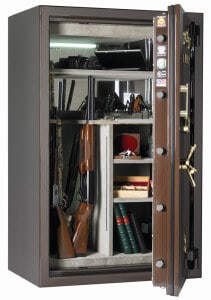
AMSEC HS7943 TL-15 Safe
AMSEC is another American company founded in the 40’s. The company and their customer support are discussed in detail above. AMSEC makes gun safes with both UL 687 TL-30 (RF Series) and TL-15 (HS Series) ratings, as well as the B-Rate BFII gun safes discussed above.
Brown Safe makes UL 687 TL-15 (HD Series) and TL-30 (HD Plus Series) rated gun safes. Brown also makes weapons-sized safes in B, C, E, and F-Rate. Other options from Brown are double-door safes and their “M-Rate” ballistic armored safes.
Brown generally puts the thickest piece of steel on the inside, which is an advantage for theft and fire protection. In terms of fit and finish, Brown’s can be a little less refined than the other brands, which is part of their niche. They meet the same performance specifications as other safes with comparable ratings, but holding close tolerances on large pieces of steel is expensive.
There are many small manufacturers of true safes. These companies may have different relationships with local safe dealers. If you’re looking for a gun safe you should talk to a true safe dealer. They’ll be more knowledgeable about these units and the particular benefits of each. Since they also maintain the units they sell, they can also inform you of specific issues they see with them too.
A safe dealer should be a member of the Safe & Vault Technicians Association (SAVTA) and/or National Safeman’s Organization (NSO). You can find these businesses in this online directory, or by looking up “safes” in the yellow pages.
Safe dealers may have a used true safe in inventory that could fit your guns, which may be cheaper than a new RSC gun safe.
What do you think? Leave a comment below, your thoughts are welcome.
More recommendations: Best Small Gun Safe and Best Biometric Gun Safe.
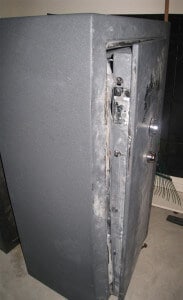

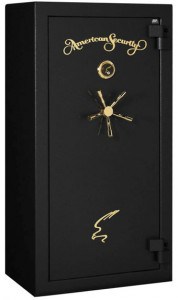
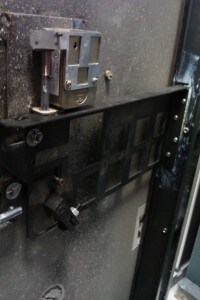
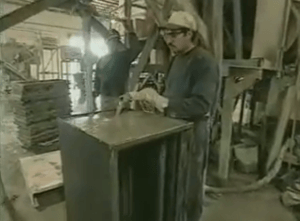
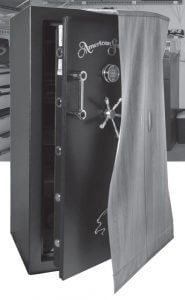
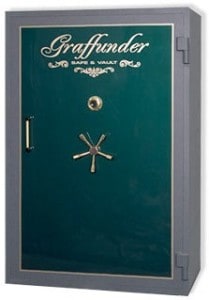
Do more reaserch on the fire gasket comparison for Amsec vs. Sturdy. Sturdy should win, because 3m fire stop is good for 4 hours, not 1 hour like Palusol, which Amsec and a lot of other companies use, because it’s easy to install and looks good.
I’d say not to give the fire rating to Amsec either. I’d tie that if I were you because there are good arguments for both sides. You based giving it to them because of it’s similarities to the UL 72 Class 350 1 Hour design, however, if you actually look at any UL 72 class 350 safe, you will notice they do not use Dry Light as an insulator, they use real cement, which is not a far comparison to Dry Light. For example of one main difference: These UL 72 class 350 safes are not made with thick steel, because they rely on the cement for it’s security and insulating value. Real cement is a great fire insulator, but the problem is, having a safe that large, with real cement, will weigh the safe down too much for most people to be able to handle. Amsecs (with their BF series safes) Dry Light does not add to the security of the safe, so they need to have the thick steel for this.
There are UL rated fire safes, that actually use ceramic insulators on the market. You can’t say that about Dry Light. Amsec would have UL Fire tested their BF if that was the case.
Thanks for bringing these points up. I’ve done more research on the door seal question and included my results above in the article.
I also spent some time looking into your comments on AMSEC’s fire rating. According to a safe tech/dealer who reps AMSEC, today the BF gun safe concrete amalgamate called “DryLight” is the same the lining in the rest of the AMSEC fire safes. However, in AMSEC’s dealer catalog “DryLight” is only mentioned for the BF gun safes and VD vault doors. This may be left over from years ago when different mixtures were used, or for marketing purposes.
To double check whether there is a difference in the concrete amalgamate I did a calculation to compare the densities of the concrete mixtures. The dimensions of the steel layers and concrete fill are all published, so I first calculated the approximate steel weight. Then I backed out the approximate concrete weight and divided it by the volume to get the density. Since this is a rough calculation, there’s some variation in the results but it seems good enough. According to my numbers, there isn’t a significant difference in the lining density of the BF gun safe models compared to the smaller UL 72 rated BF models. This implies that it’s the same stuff.
Fire safes with concrete amalgamate firelinings use 3 laws of physics to protect the contents: Thermal Mass – The heavier the lining, the longer it will take to heat up. Unfortunately it also takes longer to cool down and turns into an oven. Thermal Conductivity – The lower thermal conductivity means better insulation. Latent Heat of Vaporization – Chemicals which undergo a phase change by releasing water absorb heat, as discussed in the Fire Myths page. These chemicals include gypsum, vermiculite, perlite, etc..
The stronger concrete is, the worse of an insulator and heavier it becomes. Lightweight concrete can have a thermal conductivity of only 0.1 W/m-K (lower means better insulator) and density of 1750 kg/m3. High strength concrete can have thermal conductivity of 1.8 W/m-K (1800% worse insulation), with a density above 2400 kg/m3 (40% heavier). Although concrete thermal mass and insulation properties go in opposite direction, the insulation gets better much faster than the mass gets worse.
Generally the additives added to concrete to make it lighter also make it a better insulator, including Vermiculite 0.058 W/m-K, Perlite 0.031 W/m-K, Fiberglass 0.04 W/m-K, and Sand 0.2 W/m-K. Vermiculite and Perilite add phase change fire protection, which makes them popular with fire safe manufacturers. Portland cement as you mentioned is a decent insulator at 0.29 kg/m3, but it’s also the most expensive component of concrete. Instead of adding more cement, fire safe manufactures generally use other additives to save money and add phase change protection. Fire safe manufacturers all have their own special blends for their concrete amalgamate.
I believe that AMSEC doesn’t fire test the BF gun safes because it knows they can’t meet UL 72 Class 350. The smaller BF home safes all have that rating, but only the smallest 3 can meet it for 1 hour. The largest BF3416 is only rated for 30 minutes. As the interior size gets bigger, the walls and fire lining thickness need to get bigger too to maintain the same protection. But as you mentioned, this would make the large BF gun safes extremely heavy, heavier than gun owners want at this price point.
I made a couple changes to the fireproofing description too based on your comments, thanks!
Thanks for adding more details and further information to it.
Very very informative
Thanks! Tell a friend 🙂
Your article describes everything articulately. But I cannot understand the deference between mechanical lock and standard lock. Please can you tell me which gun is using laser-ray.
What do you mean by laser-ray?
What about safes from sportsman steel safe. They seem to be quite impressive for bang for the buck, in terms of steel thickness, fireproofing, etc. could you provide your thoughts on them? http://www.sportsmansteelsafes.com/
Hi Jeffrey,
Thanks for the question. Sportsman Steel does emphasize the important gun safe specs, like steel thickness, more than other manufacturers. They looked like a promising candidate for a recommendation. That is, until I heard accounts from customers.
Pretty consistently Sportsman Steel’s customers and potential customers have complained about high pressure sales tactics and bad customer service. After a couple dozen such stories I stopped researching them. I also found mixed reviews about their quality, but didn’t take the time to get to the bottom of them. There are enough companies out there making good gun safes that I didn’t want to steer anyone towards a vendor that had given a lot of people a bad experience. If you want to check out for yourself what some Sportsman Steel customers have said, start by checking the gun forums.
Hi, I want to buy a safe but this is way more information then I expected and all I want is one that can not be opened with a axe or crow bar, what one do you recommend that is the most cost saving as well Im looking for one that will have a few shelves and I do not need to use it for a shot gun or anything like this. I would like it to be fire resistant as this is normally efficient enough. What are your thoughts on Manual and electronic safes and which one safe that is about 3’w x 4′ or 5′ H is what Im looking for in black would be prefect. Thank you for your help. Annie
Just like to say that I own a Sportsman Steel safe. There customer service stinks and they do not do quality work. If I could I would post a picture of the inside of my door to my safe to show you.
did you here of SnapSafe bolt together safes rated 2300 deg. 1 hour
First off great articles on your site. Your research and knowledge on the subject matter shows. Because of that I wanted to ask you in regards to the Ironworks AF gun safe line. I was weighing between the AMSEC BF6030 and the Ironworks AF6033 (due to the esthetics) and wanted to see if you would weigh in on them. The one negative I have about the AMSEC is the bolt pattern is only 11 with a single at the top. This seems a bit odd and leaves the safe vulnerable to prying once either side of the doors bolts are cut thru from what I can tell (I could be wrong). Either way I’d love to see a review or comp of the Ironworks AF series safes especially compared to the AMSEC BF Gun safes line.
Thanks again and keep up the great work on here.
Hi there, jyst wnted to mention, I loved this blog post. It was practical.
Keep on posting!
This is very needed information, especially in these times. Thanks for the hard work putting this together.
Costco offers a gun safe named Sports Afield 6033 Executive vault. Do you have an opinio on this safe. After reading the info you provide I am skeptical of the safe.
Thanks
One other thing would you mind reviewing the safes at thesafecompanystore.com
Thanks again.
Hi there! I am putting some thought in the information you gave on your site. It is outstanding but overwhelming for someone like me. I want to buy a Christmas gift for my husband. I am the more informed buyer at our home and also the one who finds the best buys so my husband would be happy if I did my homework for him and got a decent safe and deal. I thought about the Security Safe Co. checking out what I buy from Craigslist like you mentioned in he article but I found this listing and I am not sure of the name – Can you advise me? I tried to google different names but did not find it.
Thanks!
Jennifer
Here’s the link!
htp://seattle.craigslist.org/tac/tls/4786245648.html
Bear safes I beleave are one of the best and you did not mention them.
All USA Made also. Just check out their website.
Thanks Keith Welch
Have you reviewed Stackon gun safes? any thoughts, I know some people who have them but dont really know much about them.
Thanks
Merry Christmas!
Great info! There’s a Cannon Safe dealer in my area. They seem to push the fire rating pretty hard and the steel on the best ones is 10 gauge. The rest are 12 or 14 gauge. Not sure how gauge thickness compares to inches but many thanks for your help in my education process.
Happy holidays 🙂
Hi Guy, Thank you! There’s a table in this section which shows steel thickness in inches for each gauge.
Also, What to Look for In a Gun Safe has summary recommendations for each gun safe specification, including steel thickness.
A great holidays and New Year to you as well!
So glad I came across your site. I’ll recommend this site to others. Start of finish I’ll read every word.
Thank you
Very good information placed on this website. The only thing I would add is a comparison chart that would list the obvious between all the safes. Such as: price, weight, fire rating, customer service, size, warranty, quality, Consumer Report Rating, etc…
Thanks for the help.
I really enjoyed the review of the Amsec. My question is on Customer service AFTER you make the purchase. I just bought a Cannon Armory and had it delivered on January 3 of this year. The safe has been defective since delivery and you can’t get customer service or anyone from Cannon to lift a finger to do anything. After nearly 2 months, I’ve had 2 locksmiths sent here from Cannon with either the wrong part or without lock code info to fix the piece of junk.. DON’T BUY A CANNON SAFE…..Go with Amsec or anyone else, just don’t buy Cannon.
Great website and a treasure trove of information. Thanks for pulling together this information. Very helpful.
Thank you so much. All I wanted was some more information on the AMSEC BF safe, and I got way more than I bargained for! I did see the AMSEC BF has a 4 gauge upgrade on the inner liner (which I found odd, why put the thick stuff on the inside until you talked about the inner layer for fire reasons). The one on AMSEC’s website did not work but I found a chart that worked below:
http://www.coloradostatesafeandlock.com/images/pdf/AMSEC_2014_Gun_Safe_Comparison_Chart.pdf
After reading the information, I actually think I may go with a Sturdy! Thanks again
It seems like getting a gun safe is an important thing to have. Especially if you have children, having a place to lock up your guns will prevent accidents. Whenever my uncle gets back from a hunting trip the first thing he does is puts his guns away. safeswarehouse.com.au
Can you please tell me if you have any information on Ft. Knox safes?
I am thinking about purchasing a Cannon Safari 64 series – its on sale – how bad/good are these safes?
I am in need of a good safe and could use a recommendation for 3 ARs and 4 pistols noting I do have kids in the home.
Water and Fire resistance are higly preferred but based on the article not all required
Any suggestions?
I own an older amsec 1990’s gun safe after seeing some drill attacks on Youtube I removed the inner door to see what the lock looked like it was very simple one locker from the combo. When I bought the safe in the 90’s I only owned a small collection but now over the years it is worth 20x what I paid for the safe. Now days with the cheap LCD borescope cameras sold at Harbor Fright it would be easy to drill a couple of holes and push the locker back and rotate the handle. What kind of protection on newer safes have been done to stop drill and scope attacks?
You can also increase the capacity of your gun safe with a MOLLE Gun Safe Door Organizer Panel. These are custom made to precisely fit your door.
http://www.wildebuilttactical.com/store/molle-safe-panel-organizer
Thank you for the info I just have one question, I’ve already made the mistake of a Chinese gun safe in the past and know how important USA made is but I’ve heard a lot of good about Steel Water and love what you get for the price. Would you still advise against that safe?
What are your thoughts re: Big Horn, Cannon and Sports Afield safes sold at Costco? Thinking about the 800 or 1000 Big Horn safe or a Liberty RE18 (factory second) for 600 from a local store. Thanks.
Jaime, do you have any opinion of Fort Knox RSCs? To my untrained eye, they appear to be similar to AmSec in quality and construction.
Hello i have been researching safes for my home and along the way i was told the designer of the fort knox safes are the owners of champion safes which have a very similar build. Problem is i am not sure if this but the sales rep seemed to lay it out very well and said he will not say anything bad about any safe company. But it was good information.
Do you have any opinion on Pella Security safes from Pella,Iowa?
My dad is really big into guns, and his birthday is coming up. I know he doesn’t have a good safe to put them in, and that is what I’m wanting to get him. That being said, I really appreciate you giving me some insight about this gun safe, and letting me know how reliable it is. I’ll be sure to check this out and see if it is something my dad would be interested in. Thanks for the help.
HI All,
I spent 6 months reviewing safes and my ol lady finally decided that I can
upgrade from my small one that I had for 20 yrs.
Although I like the Sturdy Brand and enjoyed viewing the break in attempts
by the owner of SteelWater Safes…I realized two things…
For the amount of protection I wanted 7 ga min..with fireliner, inside 10 gauge stainless steel liner, hard plate upgrade, bolt down holes, over 6 ft tall…. It was gonna cost me a little over 5 K. And I could not afford a http://www.graffundersafes.com/
Because that safe would exceed the value of my goodies…
1. Buy Bigger than you need.
2. Remember RSC gun safes are just that…a container you store all your stuff into they can look pretty and have a cool inside with lights and all kind of nice features but in the end they are rated 5 min for break-ins.
So this is what I did…
I think it might of been a little overkill with a 2 hr fireproof rating and
pretty much Burglar Resistant for 30 min…
So I ended up with a USED Jeweler/Pawn Shop Safe that was pro
moved and installed. This is a TL 30×6 safe with two dial combos. That means all 6 sides have the same strength and steel around. (Not Just the door) There are a few of these safes that come to mind, Surrimax ,Mosler, Amsec ,Kaso ,ISM, and Mutual…some like Bernardini are nice but are not made anymore.
My safe has two group 2 combo dials..They are independent of each other…wish they were group ONE but
it was too expensive to redo, and just not needed.
It has glass in the frame which If and when drilled, will set off some relockers.
The safe weighs 2 tons and I cemented it in. Now to be honest, a safe is to
deter the common crack head from getting at your stuff. Any Safe can be broken into given time. (Mine is not torch resistant) Please look up any safe TRTL 30×6 for the next model up from mine. A vault at your bank for instance is usually a TRTL 120..with time lock/cameras/Alarms. Just to show you they broke into some vaults in the UK that was holding millions in diamonds over a holiday weekend.for a tuesday Jewelery show. and .the badguys did leave a $5000 drill, to show you what it took to break in.
Anyway
Most home break-ins happen within 7 min and
these people are in and out before your police are dispatched and show up.
You want to minimize the time these bad guys have breaking into your house.
So in addition to my ADT system/Motion and a DVR with Cameras all over,
the best thing you can do is NOT advertise your goodies.
Good luck and be safe.
The best info on safes I’ve found! Thanks so much!
I hope I get the math test right!
Hi. I’m at the framing stage of building a house and am considering a true safe (Graffunder or Amsec or just getting a vault door (same companies) and building a room out of cement (like 6″ thick Fox Blocks ICF). The room would have the advantage of size, tornado shelter, panic room, etc, but would 6″ of concrete be even close to a door of a true safe regarding theft protection? If not, how much concrete would you estimate it would take so that the walls were equivalent in theft prevention? Thank you. Great article!
Any reviews/comments/ratings on Summit Safes?
Hi,
Thanks for sharing this informative and fabulous post. Please keep writing.
Excellent and informative.
I would like your opinion on a Liberty Fatboy, not the Jr., but the biggest safe! Compare it to the Amsec and the many other large safes please!
I have read numerous comments by many manufacturer people as well as dealers, the entire issue has me baffled!
The Fatboy has 14 locking bolts, two top and bottom and five each side, it has no exposed hinges, and the higher models offer more and larger diameter bolts, longer they claim then competitors, steel gauges shown are also heavier, fire resistance is up to 2.5 hours, but the temperature seems low, anyway, please comment! I live 20 miles from Amsec, will purchase very soon, and have delivered inside and bolted to a concrete floor!
I have a substantial weapons collection, some top end collector editions, so I Am seeking a high quality, very secure safe. The collection is inherited, but not in my home as yet, so until I get a good quality safe, I will not be a target for criminals seeking my weapons!
My knife set is actually worth more then the gun set! I will be purchasing four of the same safes, for Long Guns (2) with ammo and other valuables, for handguns (1) with ammo and knives, for knives (1) with other valuables, and for several collectible weapons (1)
All will be located in several different locations within my home, no two in the same location!
Both fire and theft are my concerns, since many insurance companies are getting extremely tight on covering guns in California!
Please let me know your comments!
In the fire protection section, it’s sounds like you are saying the BF3416 has the same type of insulator as the Amsec BF (larger) gun safes, but it doesn’t use DryLight as an insulator at all. It’s a different type of fill from what I gather. If it’s not DryLight, why mention the BF3416 like it’s something to be compared?
Looks like Sturdy offers thicker doors with some packages now too.
This article was very informative though. Thank you.
Hi,
Looks like that isn’t your real email so you probably won’t see this, but I wanted to respond.
AMSEC used to be cagey about admitting that the same DryLight fill was used on the BF true safes and BF gun safes. A couple years ago a reader and I were discussing it. After thinking about it, I actually took two models, calculated the weight of all the steel, and approximated the density of the fills from the total weight. The BF gun safe fill was very close to the same density as the UL 72 rated BF safe I chose. From then on I claimed they were the same. A couple years later AMSEC now advertises that the BF gun safe uses DryLight in promo videos.
You’re right about the Sturdy options changing. AMSEC also now offers a HD option which coincidentally increases the inner liner up to the same thickness as Sturdy’s optional outer liner. I’ve been updating all the information.
Cheers,
Jaime
Excellent and complete write up. Thank you! Understanding that AmSec and Sturdy are great, how do you feel about the Champion Crown with the Delta Force doors? 3/16′ bodies, multiple relockers, 3/8″ steel panel on outer door with 10 gauge inner liner. 1900+ lbs for the 65 cu foot model. Seems competitive but you have a keen eye for differences…very interested in your opinion
All the best,
Pete
Do you have an opinion on Heritage. I have a mid size one now only because it was the largest that we could get into our basement (not a walk in). We are building a new home and I am considering there top of the line safe which weighs over 1 ton. I do want fire protection, but mostly vandal protection as we are building on our farm and the home will not be visible from other homes. Thank you for a reply.
I think this is an Amsec BF getting axed into in 45 seconds. The way you describe it makes it seem stronger. https://www.youtube.com/watch?v=RXVfVUW2ZkI
I also believe this is an Amsec BF linkage that bent easy. https://www.youtube.com/watch?v=Y7X8crrn0Kg
Brown Safe seems to acknowledge Sturdy Safe as a “True Safe” and the Amsec BF, even the HD, as just an “RSC”. http://www.brownsafe.com/gun-safe-reviews/index.html
Any thoughts?
Hi Kirk,
Thanks for your comment! I reviewed this article and realized that I had written things on other pages that weren’t clear here. Since a lot of people reach this page first, I elaborated. I was also mentally averaging my BF/Sturdy burglary rating between the base and optional upgrades. I’ve now separated them. In general on this site, I try to avoid pointing out specific ways that products can be defeated. Once that information is published in a YouTube video though, there’s no reason not to discuss it. I included your video above.
The second video does appear to be an AMSEC BF linkage. I don’t disagree that the chrome locking bolts are cosmetic features, and that fixed hinge-side bolts are preferable. I also pointed out advantages of the Sturdy bolt work. However, the video is a little misleading. For one, the Sturdy bolt work is stronger because it has to be. The BF has a 1/2″ plate steel door. A rigid door in a rigid frame takes less strength to hold closed. In the beginning of the video, notice that Terry points out that the true safe has a 1-1/2″ (1.5000″) plate door and 1″ (1.0000″) plate walls. The Sturdy is much better than the majority of gun safes, but their base door is still 25% thinner than the BF. BTW, I’m not saying that this is a bad tradeoff to make at this price point, but it’s worth saying. Neither has a solid steel door frame, but the BF has true composite construction a cast fill. Also to be fair, the Sturdy bolt work itself is somewhat of a cosmetic feature. It looks similar to some true safe models, but has significant differences. For one, the bolts are not hardened. Most true safes don’t have pretty bolt work. It’s designed to keep the door shut, be serviceable, and reliable.
I see what you mean. Brown included AMSEC BF6636HD in the RSC section, but some of the text refers to the non-HD option. Then they included Sturdy 3224-6 in the True Safe section. This looks like some creative marketing. AMSEC is one of their primary competitors, so they may be taking some liberties…
True safe, a phrase Brown also uses on that page, does have a specific meaning. Insurance companies specify the construction and ratings of safes before they will insure the contents. Generally a B-Rate or higher is required for any commercial application. Sturdy makes good products which fit a specific market niche well. However, they have never had their units independently tested for any rating, so they technically shouldn’t even be listed in the RSC section. AMSEC on the other hand has products from RSCs to fire safes to true safes. Many of those products compete directly with Brown, including one of the only other TL-rated gun safes. The BF HD version does meet the composite definition of a B-Rate safe.
Cheers,
Jaime
I bought a Sturdy around 2004-5 after seeing their photos of a Sturdy standing on the empty slab of a burn-down. The safe was allowed to cool, then opened. There were Ruger pistol boxes inside, undamaged. Ruger pistol boxes are made of recycled milk jugs, they begin to ‘slump’ and distort at low temp, 242 F IIRC. Seems like a nice bit of info to pass on as regards their FP design.
https://www.youtube.com/watch?v=DetROu9hTSQ
Would like to note that all of the Job boxes I have looked at, Rigid, Knack, and Lund are only 16ga steel. With some have 12ga around the locks. Some also have 14ga or 12ga feet on them.
I would really like to know what your thoughts on a steelwater. I like the Sturdy safe but the difference in price steelwater sure looks good thanks
I used to install gun safes in ppls homes. U failed to mention anything about placement of safe. Where u place ur safe has alot to do with how secure ur safe really is. U want to place ur safe in a way that it makes an axe attack on its sides or door prying difficult. Like in an interior closet. Just some added 2 cents
Hi Brian,
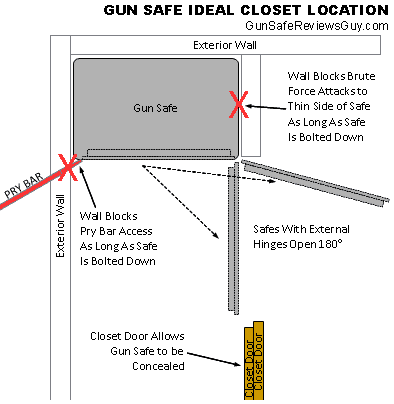
You’re absolutely right. To keep this page from getting too long I put the where to put a gun safe topic on its own page. A closet is one of my favorite locations too. In fact I drew up a diagram on that page depicting just what you described, i.e. how it can protect against axe and pry attacks.
I’ll have to review this article again and make sure that’s clear.
Thanks for the help!
Jaime
I purchased a 72 ” ZA-2 Zannotti Armor safe back in 2006. Skeptical, I visited the factory in Cedar Rapids, IA on one trip to see family in Des Moines, IA. The owner, Mark, greeted me at the door and gave me the tour of the plant and answered all of my questions. The whole process of building the safe is painstakingly accurate. The final quality control step was a complete construction, at the factory to make absolutely sure the safe will fit together tightly at the customer’s installation site.
The electronic lock option was phased out in late 2006. I had a choice of two (2) combo lock and I chose the better of the two.
The safe was delivered in three (3) large boxes, from R&L carriers. My neighbors never knew what was delivered. NO “Acme” safe company truck was parked outside telling them what I had. The safe was installed in my basement store room. Easy to assemble and place where I wanted.
Since then, I moved outstate taking this safe with me. Unpinned without issue. Movers didn’t squawk. Reassembly, in an upstairs closet was a snap (with 2 people). The combo lock works as I expected it would.
One last point, Zannotti Armor’s customers are primarily police officers and military personnel, since they move around a lot and have the need to protect their weapons.
If you are thinking portability since you move a lot, look no further. I cannot say enough good about this company’s product!
Thanks for your comments on the Zanotti modular safe.
– How secure is it vs. a safe with welded walls?
– What would you change to make the safe better?
What is the difference between a Liberty Revere and the American Security FV series. Are they the same quality. The FV series includes the door pockets,ect
I just wanted to let you know that I am personally sad about the lack of support Winchester Safe Co. has offered my daughter and son in law at the time of their recent house fire (May 19). They live in Madison, Virginia. They purchased a Winchester Safe in November 2016 (six months ago).
They contacted customer service department within two days of their fire explaining that they could not get into the safe. After another couple of days, it was suggested by your CS representative that a new “key pad” would probably correct the problem and that one would be mailed out.
It was. It did NOT correct the problem. Then it was suggested that a locksmith could be called. (He was. He responded but could not access the safe)…
then a Winchester locksmith was dispatched and today they were able to find their most prized possessions full of mold, mildew and dampness that could have ALL BEEN AVOIDED if Winchester had responded at the first phone call.
At a time of duress (losing three pets in the fire, losing most of their clothes, furniture and having to rebuild their home from the studs)…and in all other hardships that this couple has had to face, I want to say SHAME on Winchester for making this one of their worries. I do not see why THEIR homeowners insurance should have to replace and repair gun stocks, and valuables that didn’t HAVE to be damaged by three weeks of waiting on mold to set in. I understand that a new safe has been offered to them. Seriously, I hope they do not accept that offer / clearly this product cannot protect valuables. My hope is that Winchester will refund their money (they have a receipt from Tractor Supply Co.) so that they can buy a better product based on the recommendations outlined in this blog post.
Lastly, thank goodness for an honest community. The safe has been in an unlocked / unsecured (walls demolished preparing for repair) home while waiting for the Winchester locksmith.
Perhaps the safe is good quality. The customer service offered to this young couple was NOT good quality. Just beware of WINCHESTER.
Hi Tracy, Sorry to hear about your family’s house fire and hardship. Thank you for sharing your experience with other readers.
Curious if your research has covered Steelwater Safes. I saw a post above, but I don’t; think there was a reply.
Any thoughts?
Thanks
What is your opinion on the Superior Untouchable Safe; how does it stack up to Sturdy Safe?
Jamie,
I was burglarized about a year and a half ago and now that the cases are completed was looking at your website again to see what new things you’ve added. I’m a Certified NRA Firearms Instructor and I’ve recommended your site to students when we come to adequate and proper storage as an additional point of reference and information.
When I was looking at what I needed to improve my security of valuables and firearms, I used your very informative site as a starting point and found it extremely useful. I actually contacted Brown Safe Co., AMSEC, and a couple other safe company’s you have listed. Since the economics are as important as the security. I found the best value with a Brown Safe for cost and security vs volume (size). I would be willing share with you some additional information since Brown Safe Co. was not on your list of safes.
Keep up the great work. I still find your information spot on and it helps educate anyone who is really looking at security for their valuables and firearms.
Sincerely,
Hi Carl,
Thanks for the kind words and recommendations. Sorry to hear about the burglary.
I always appreciate users’ first hand experience with products discussed on the site, and feedback regarding omissions/errors.
I sent you an email.
Thanks!
In the UK, I found the Phoenix Lacerta to be a good gun safe. You can see photos and the full spec here
Jaime,
Great site and thank you for sharing your detailed and deep knowledge of gun safes. Love the clear, factual presentation of the material. Very interested in Brown Gun Safes at the moment.
Have you ever reviewed Brown’s HD Plus TL-30, or TL-15 gun safes? While they are not UL 72 certified (and I’m beginning to wonder more and more what non-UL 72 certified fire proofing is really buying me) Their HD TL line seems to be pretty well constructed and do seem to be UL 687 certified. Their sales rep mentioned a UL 350 certification. Never heard of that. But would be interested in your thoughts about Brown.
I am looking for a true safe for documents and guns. So far I have looked at Rhino and American Security. Have you considered comparing the two? I didn’t see Rhino in your review and someone told me that their electronic locks are not very reliable. Can you shed any light on this?
combination rifle and handgun safe
I own a 40-UU from Drake Safe Company in Roxboro, NC. Fully welded seams, fireproofed, super tight, custom fitted doors, and (best of all)….the entire safe, including door and all walls, and the door frame, is constructed from 1/4 steel. This 40 gun rated safe with three upper shelves is $3000. I’ve had mine for more than 20 years and am ready to buy another. Please look at this maker, and review.
Thank you so much for the detailed information!
Clearly a labor of love and helping a lot of people!
Thank You!
Kevin
I see your continued comments about Liberty’s Centurion, but what about their Franklin and Lincoln safes?
Their commercials sound too good to be true, so I had to go looking for negative reviews. How do they stand up against someone determined to get in with tools and time?
I am looking for a good solid safe that will not be able to be broken into while onsite, as the placement of the safe will prevent it from being removed.
I will have a few long guns (5 or less), but the safe will be used more for my antique Japanese swords (just as long as my guns, some longer), as well as many other valuables and important documents.
I was originally looking to spend $2-$3 k, but looking long term, I want to make sure whatever I am going to purchase will be reliable to protect $50-$100 k worth of items someday, so price can be more as the protection is what will be important.
Professional advice of someone not trying to make a sale is really appreciated!
Hi Jaime,
You’ve put together an absolutely awesome website. Thanks for assembling and sharing all this information.
One point does confuse me. You write, “14 gauge is thinner than your average $250 jobbox toolbox.” The boxes in the pictures and Amazon link are made primarily of 16-gauge steel. Some components (e.g., the skids) are made of thicker steel. Are you aware of job-site boxes whose entire bodies are made of steel thicker than 14 gauge? I would appreciate a pointer to one.
Hi Nick,
Thanks, and thanks for your comment.
You’re right. Not only is the $250 model I was referring to now $300, but it looks like other units I remember have either gotten thinner or much more expensive.
I’ll have to survey the market again and update that description on my next pass through the article.
Awesome article. I’ve been referring back to it for years. Do you have any thoughts on Amsec’s BFII safes? I’m not sure when these came out but there is now a BFII sister to every BF safe model. What are the differences? Looks like thicker steel? Do these replace the BF HD models?
Hi Dan,
Thanks for the kind words and for reading. Yes, the BFII is the first gun safe to meet the new RSC Level 2 specification. They’re stronger and heavier than each of their now-discontinued BF-HD predecessors. I’m working through updating the site to get it up to date.
Thanks! Jaime
Great article!
You mentioned in the section comparing door seals that, “STI LCI300 doesn’t publish its expansion temperature”. This may have changed as I’ve seen several spec sheets such as https://files.stifirestop.com/4.%20Product%20Data%20Sheets/1.%20English/PDS_LCI%20Intumescent%20Sealant.pdf which state that expansion begins at 350 degrees F.
Thank you for all the great info. I have a question about whether or not either of these safes are waterproof. If I put a safe in my basement that has a fire rating, and the fire department unloads several truck-fulls of water into my basement, will the heat generated from the fire seal up either of these safes and keep out all the water the fire department would flood into my basement?
Thank you,
Hi Jeff, thanks for reading and for the comment.
You can find my thoughts on “waterproof” gun safes here.
Basement fire protection issues can be found on this page in the fire section.
If you’re looking at different locations, Where to Put a Gun Safe has tradeoffs for each scenario.
Cheers,
Jaime
Thanks, I’ll check those out.
Can you review and compare the Ironworks USA brand and features? I think their Rhino USA and Kodiak Imports brands at a lower level. Hopefully their Ironworks USA models aren’t just cosmetically mocked up to look “tough”. I’d love to support a made in the USA brand that is actually really good.
Hello,
I was a bit overwhelmed by all of the information offered here. I do see that you have done intensive research so wanted to ask you if it would be possible to get a decent long gun safe with a budget of only $500?
Thanks!!
Hello JAIME,
What a brilliant job you have done!! My goodness!! You really done a very good job. It is really cool artcile. Usually, such types of detail as well as deep research article don’t get available. You work hard on the article, so that you can write so deep. The specifications are so sensitive and specified. I like your work and I always like to feel that there is a pure source from where I can get all the informative solution.
All types of comparision you managed and you discussed all types of products as well as all types of brands, so that I can or we can get detail idea from your article.
Shair
Why weren’t Fort Knox safes mentioned?
Glen
I love how informative and well-detailed your articles are, I’ve learned enough about the best gun safes and getting the ideas and tips benefits to the readers from your article. I’m thankful I found this and every details you put is a masterpiece. I’m looking forward to reading another article of yours. Kudos!
Corey.